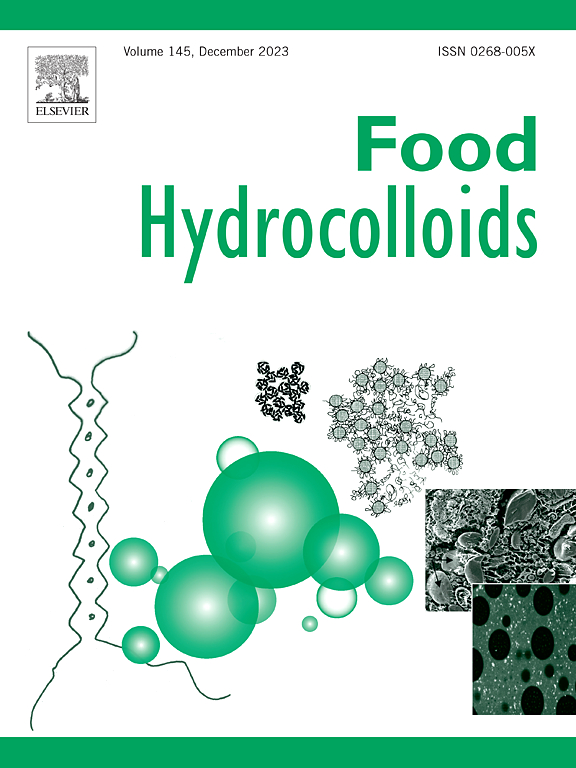Underlying the effect of TGase-catalyzed glycosylation of fish gelatin: Perspective on structural characteristics, physico-chemical properties and functional properties
IF 11
1区 农林科学
Q1 CHEMISTRY, APPLIED
引用次数: 0
Abstract
This study investigated the effect of chitosan-oligosaccharide (COS) glycosylation catalyzed by transglutaminase (TGase) on the structural, physico-chemical, and functional properties of fish gelatins (FG). The differences in the interfacial and antioxidant properties of FG and glycosylated FG were also evaluated. When the ratio of FG to COS in the system was 2:1, the introduction of sugar groups reached its maximum. The analysis of secondary and tertiary structures and molecular docking of proteins showed that the binding between FG and COS was mainly involved in hydrogen bonds and hydrophobic interactions. Scanning electron microscopy and transmission electron microscopy revealed a more uniform and denser microstructure of glycosylated FG. Rheological analysis exhibited that the degree of glycosylation increased the apparent viscosity of FG. The interfacial absorption behavior at the oil-water interface was assessed by three-phase contact angle and interfacial tension. These properties determine the emulsifying capacity of glycosylated FG. Moreover, the emulsifying, gelling, and antioxidant properties of FG were substantially improved following COS glycosylation. This study further deepens the understanding of the interaction between COS and FG, and promotes the potential application of glycosylated FG as an antioxidant emulsifier and gel-strengthening agent in functional foods.

tgase催化鱼明胶糖基化作用的基础:结构特征、理化性质和功能性质的观点
研究了转谷氨酰胺酶(TGase)催化壳聚糖-寡糖(COS)糖基化对鱼明胶(FG)结构、理化和功能特性的影响。研究了糖基化FG和糖基化FG在界面和抗氧化性能上的差异。当体系中FG与COS的比例为2:1时,糖基引入量最大。二级、三级结构分析和蛋白质分子对接分析表明,FG与COS的结合主要以氢键和疏水相互作用为主。扫描电镜和透射电镜显示糖基化FG的微观结构更加均匀和致密。流变学分析表明,糖基化程度增加了FG的表观粘度。用三相接触角和界面张力评价了油水界面的界面吸收行为。这些性质决定了糖基化FG的乳化能力。此外,COS糖基化后FG的乳化、胶凝和抗氧化性能得到了显著改善。本研究进一步加深了对COS与FG相互作用的认识,促进了糖基化FG作为抗氧化乳化剂和凝胶增强剂在功能食品中的潜在应用。
本文章由计算机程序翻译,如有差异,请以英文原文为准。
求助全文
约1分钟内获得全文
求助全文
来源期刊

Food Hydrocolloids
工程技术-食品科技
CiteScore
19.90
自引率
14.00%
发文量
871
审稿时长
37 days
期刊介绍:
Food Hydrocolloids publishes original and innovative research focused on the characterization, functional properties, and applications of hydrocolloid materials used in food products. These hydrocolloids, defined as polysaccharides and proteins of commercial importance, are added to control aspects such as texture, stability, rheology, and sensory properties. The research's primary emphasis should be on the hydrocolloids themselves, with thorough descriptions of their source, nature, and physicochemical characteristics. Manuscripts are expected to clearly outline specific aims and objectives, include a fundamental discussion of research findings at the molecular level, and address the significance of the results. Studies on hydrocolloids in complex formulations should concentrate on their overall properties and mechanisms of action, while simple formulation development studies may not be considered for publication.
The main areas of interest are:
-Chemical and physicochemical characterisation
Thermal properties including glass transitions and conformational changes-
Rheological properties including viscosity, viscoelastic properties and gelation behaviour-
The influence on organoleptic properties-
Interfacial properties including stabilisation of dispersions, emulsions and foams-
Film forming properties with application to edible films and active packaging-
Encapsulation and controlled release of active compounds-
The influence on health including their role as dietary fibre-
Manipulation of hydrocolloid structure and functionality through chemical, biochemical and physical processes-
New hydrocolloids and hydrocolloid sources of commercial potential.
The Journal also publishes Review articles that provide an overview of the latest developments in topics of specific interest to researchers in this field of activity.
 求助内容:
求助内容: 应助结果提醒方式:
应助结果提醒方式:


